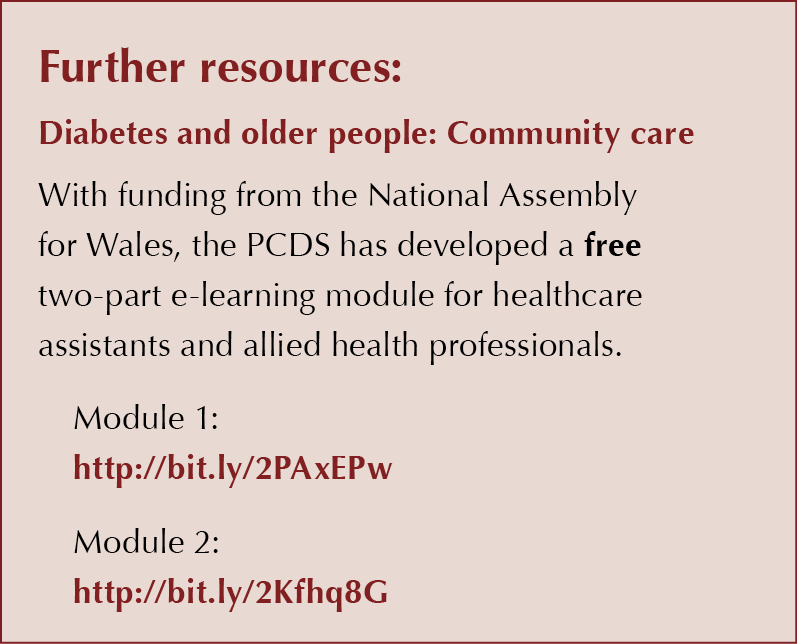The global increase in diabetes prevalence is staggering – last year it is estimated that there were 451 million people (age 18–99 years) with diabetes worldwide, and this figure is expected to increase to 693 million by 2045 (Cho et al, 2018). Epidemiologically, much of this increase is in those in the 7th and 8th decades of life (Whiting et al, 2011).
Within care homes, the prevalence of diabetes is high – the Birmingham Study, using oral glucose tolerance testing, showed a prevalence of 27%, many of whom were residents previously undiagnosed (Sinclair et al, 2001). In this study, measures of fasting glucose and HbA1c were not helpful in identifying undiagnosed cases.
Within a care home environment, where advancing age, chronic disease, frailty and disability concentrate among residents, diabetes imposes an extra health burden that stretches the capacity and skills of many care staff beyond their ability, and it is no wonder that hospital admission results. Residents with diabetes are often complex in both their illness profile and in their required management. This creates a challenging scenario for effective medical care for both home staff and primary care services (Sinclair et al, 2015).
Whilst preventing avoidable hospital admissions is an important goal of care in residential and nursing homes, there is an increasing recognition that preventing hypoglycaemia, minimising skin, bladder and chest infections, and tackling diabetes foot disease, all of which increase admission rates themselves, are also paramount objectives. More recently, frailty detection in primary care has become of importance, which is appropriate since frailty per se has more of an influence on clinical outcome than diabetes complications or co-existing comorbidities (Strain et al, 2018). But which frailty assessment tools are best (valid, easy to use and reproducible) in primary care settings and what should clinicians do once frailty is recognised? This is a topic for further discussion elsewhere, but interventions to promote exercise-based programmes in care home settings are now being advocated (Laffon de Mazières et al, 2017) and a framework for promoting a greater focus on assessment of frailty in primary care in those with diabetes has recently been published (Strain et al, 2018).
For the first time, we have hypothesised how the marked deterioration in health status occurs in a resident with diabetes. It involves an early phase of physiological dysregulation and disturbed homeostasis precipitated by malnutrition, decreased physical activity, a catabolic state, dehydration, comorbidities and medication side-effects (Sinclair et al, 2018). This creates the optimal environment for other processes, such as accelerated muscle loss, sarcopaenia, hyperglycaemia and hypoglycaemia, peripheral vascular disease, neuropathy, and decreased physiological reserve, to lead to a state of advanced functional decline, frailty and a disabling illness. In this state, the resident will feel miserable, be unable to do much, possibly be bed-bound and be losing weight, while their family will feel little can be done now for their loved one.
We have no clinical trial evidence to tell us what we can do to prevent these unwanted sequelae of admission to care homes in someone who has diabetes on admission or who develops diabetes as a resident. Preventative actions must be a priority, but first we must address the shortcomings already recognised in these settings.
A relatively recent audit of diabetes care in English care homes revealed little evidence of screening for diabetes at admission, a lack of effective communication between primary care services and care homes, and an inadequate availability of training and education resources for care home staff (Institute of Diabetes for Older People and Association of British Clinical Diabetologists, 2014). However, the lack of any obvious regulatory oversight of these deficiencies of care was later met by guidance on minimal diabetes standards being prepared for care home inspectors through collaborative work between the Joint British Diabetes Societies (JBDS) and the Care Quality Commission (CQC; 2015). This emphasised the importance of each care home having a fully stocked hypoglycaemia kit and having diabetes foot risk assessment procedures in place. This guidance was timely, but there needs to be more momentum to have such guidance implemented. It is hoped that commissioning groups and private independent owners will take this on board.
We already have in place national guidance on managing diabetes within care homes, published by Diabetes UK (2014). This has been moderately effective in promoting better improved care, particularly in encouraging all homes to have a diabetes policy of care and a designated member of staff who leads on this. Such a policy of care might include how primary care and care homes liaise with each other to be more alert to changes in the health status of residents with diabetes. This might include weekly reviews of those who are experiencing frequent “hypos” or glucose readings greater than 12 mmol/L, or who are unwell and developing infections that need early treatment. Ideally, GPs should take a leadership role where this is feasible. The recent publication of revised national guidance on end-of-life care in diabetes (Diabetes UK, 2018) also provides a framework for delivering safe, appropriate and compassionate care for those residents who are entering this phase.
It has been proposed that the future for this arena of diabetes care is a national and international call that places the responsibility on all stakeholders involved, from both public and private domains, to invest in additional resources, equipment, facilities, trained staff, and new interventions to ease the vulnerability and improve the outcomes of adults with diabetes living in care homes (Sinclair et al, 2018). This cannot happen, however, unless attitudes of clinical behaviour change in both primary care and diabetes and geriatric specialist services.






SURMOUNT-5 trial pits tirzepatide against semaglutide, plus behaviour change support, for weight loss.
15 May 2025